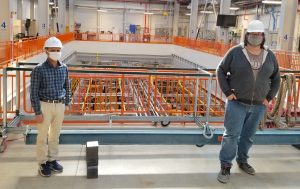
Story by Bob Wilson
Neutrinos are the most abundant known particle in the universe. They are produced in unimaginable quantities in stars – a hundred billion of them from our sun pass through your fingertip every second. And they are strange – very strange – even for quantum particles. As they travel through space, they change their identity from one type to another, as though they were doing the Clark Kent to Superman costume change trick as they speed from where they were created to where we detect them. They are ghostly particles that barely interact with normal matter, they could pass through a million planet Earths back to back and barely notice they were there.
We know of three types of neutrino and CSU physicists have been studying them for years; they were co-recipients of the Breakthrough Prize for Fundamental Physics in 2016 related to this research. But now they are after an even stranger object – the hypothesized “sterile” neutrino, which is even more anti-social than the known ones. Other than gravity, it has no interaction with matter whatsoever! Its existence can only be inferred by the inexplicable disappearance or, by a bizarre quantum twist, appearance of the other types.

Post-doctoral research Biswaranjan (Bishu) Behera and graduate student Tyler Boone in the ICARUS detector hall at Fermi National Accelerator Laboratory (October 2020).
To search for sterile neutrinos, Professors Bob Wilson and Mike Mooney, with post-doctoral researcher Biswaranjan Behera and graduate students Tyler Boone, Justin Mueller, and Anna Heggestuen are part of an international collaboration that is on the brink of operating the ICARUS detector at the Fermi National Accelerator Laboratory near Chicago. The 60-foot-long detector, which will hold 760 tons of liquid argon at a temperature of three hundred degrees Fahrenheit below zero, was transported from its original home deep under a mountain in Italy to a location in the Booster Neutrino Beam at Fermilab. The CSU group designed and built the photon sensors for the part of the experiment that will identify cosmic radiation falling on the detector with a precision of a few billionths of a second. They also provided electronics that will split and redistribute the electronic control signals. Last month, new Assistant Professor Josh Berger and his student Jamie Dyer also joined the collaboration, bringing their theory expertise and fresh ideas on a search for dark matter particles with ICARUS.
Despite the COVID-19 pandemic, the collaboration recently was able to activate over 54,000 electronic channels and produce digital images of high energy cosmic rays passing through the liquid argon. CSU’s Boone, Heggestuen, Mueller, Behera and recent CSU graduate Christopher Hilgenberg, now a post-doctoral researcher at the University of Minnesota, were among the few university researchers authorized to be at the lab during the pandemic and play a major role in installation and first operation. In the coming months Fermilab will activate the neutrino beam and the complex process of recording and analyzing the data will begin. For more details see https://icarus.fnal.gov/ or follow us on Facebook https://www.facebook.com/IcarUSCollaboration/.


